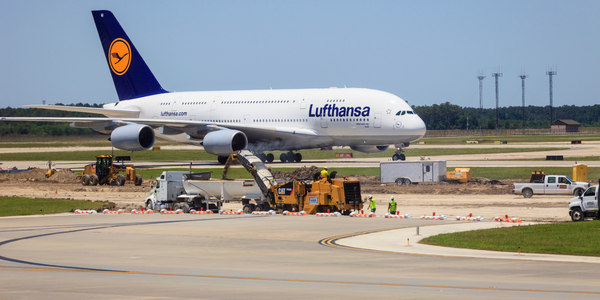Download PDF
Lufthansa Innovates Aviation Demo With Augmented Reality

Technology Category
- Analytics & Modeling - Virtual & Augmented Reality Software
Applicable Industries
- Aerospace
Applicable Functions
- Sales & Marketing
Use Cases
- Augmented Reality
The Challenge
The shipping and installing the physical demo equipment to be displayed at trade show exhibitions is expensive, time consuming and requires significant manpower.
The Customer
Lufthansa Technik
About The Customer
Lufthansa Technik provides maintenance, completions, repair, and overhaul (MRO) services for aircraft, and maintenance, repair, and MRO services for engines and components. The Lufthansa Technik Group consists of 32 companies with more than 25,500 employe
The Solution
The Lconnect AR app is using Wikitude Image Recognition technology to scan a marker image that adds a virtual 3D model of an antenna installation process (radome with satellite antenna inside). For trade shows, a 2m x 3m segment cutout of an aircraft fuselage was produced and positioned at the booth. The virtual augmentations sit on top of the aircraft fuselage and the projection has a 1:1 real-life scaling, which gives all viewers a high degree of immersion.
Data Collected
Product Images
Operational Impact
Related Case Studies.

Case Study
Airbus Soars with Wearable Technology
Building an Airbus aircraft involves complex manufacturing processes consisting of thousands of moving parts. Speed and accuracy are critical to business and competitive advantage. Improvements in both would have high impact on Airbus’ bottom line. Airbus wanted to help operators reduce the complexity of assembling cabin seats and decrease the time required to complete this task.

Case Study
Aircraft Predictive Maintenance and Workflow Optimization
First, aircraft manufacturer have trouble monitoring the health of aircraft systems with health prognostics and deliver predictive maintenance insights. Second, aircraft manufacturer wants a solution that can provide an in-context advisory and align job assignments to match technician experience and expertise.

Case Study
Aerospace & Defense Case Study Airbus
For the development of its new wide-body aircraft, Airbus needed to ensure quality and consistency across all internal and external stakeholders. Airbus had many challenges including a very aggressive development schedule and the need to ramp up production quickly to satisfy their delivery commitments. The lack of communication extended design time and introduced errors that drove up costs.

Case Study
Developing Smart Tools for the Airbus Factory
Manufacturing and assembly of aircraft, which involves tens of thousands of steps that must be followed by the operators, and a single mistake in the process could cost hundreds of thousands of dollars to fix, makes the room for error very small.

Case Study
Accelerate Production for Spirit AeroSystems
The manufacture and assembly of massive fuselage assemblies and other large structures generates a river of data. In fact, the bill of materials for a single fuselage alone can be millions of rows of data. In-house production processes and testing, as well as other manufacturers and customers created data flows that overwhelmed previous processes and information systems. Spirit’s customer base had grown substantially since their 2005 divestiture from Boeing, resulting in a $41 billion backlog of orders to fill. To address this backlog, meet increased customer demands and minimize additional capital investment, the company needed a way to improve throughput in the existing operational footprint. Spirit had a requirement from customers to increase fuselage production by 30%. To accomplish this goal, Spirit needed real-time information on its value chain and workflow. However, the two terabytes of data being pulled from their SAP ECC was unmanageable and overloaded their business warehouse. It had become time-consuming and difficult to pull aggregate data, disaggregate it for the needed information and then reassemble to create a report. During the 6-8 hours it took to build a report, another work shift (they run three per day) would have already taken place, thus the report content was out-of-date before it was ever delivered. As a result, supervisors often had to rely on manual efforts to provide charts, reports and analysis.






